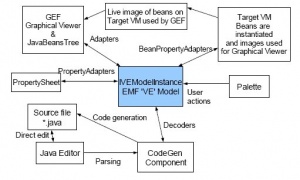Notice: This Wiki is now read only and edits are no longer possible. Please see: https://gitlab.eclipse.org/eclipsefdn/helpdesk/-/wikis/Wiki-shutdown-plan for the plan.
Architectural Overview of Visual Editor
Eclipse VE is based around a model defined with the interface IVEModel but commonly known as the VE Model. This model is based on the EMF model jcm.ecore defined in org.eclipse.ve.java.core but several other EMF models are also used. Illustration 2 summarizes the VE Model and the EMF models that contribute to it.
The VE Model is at the heart of Eclipse VE. All of the architectural components access the model providing a view to the user of information in the model and updating the model as a result of user actions. The VE Model itself is not restricted to modeling only Java GUIs as the ecore models specify that the objects that can be added to it are EObjects – that is any object that is defined in an EMF model.
In practice, though, the objects added to the VE Model are IJavaObjectInstances and all of the Eclipse VE architectural components expect this to be the case. IJavaObjectInstances represent instances of a Java object and are modeled in the org.eclipse.jem/instance.ecore EMF model.


